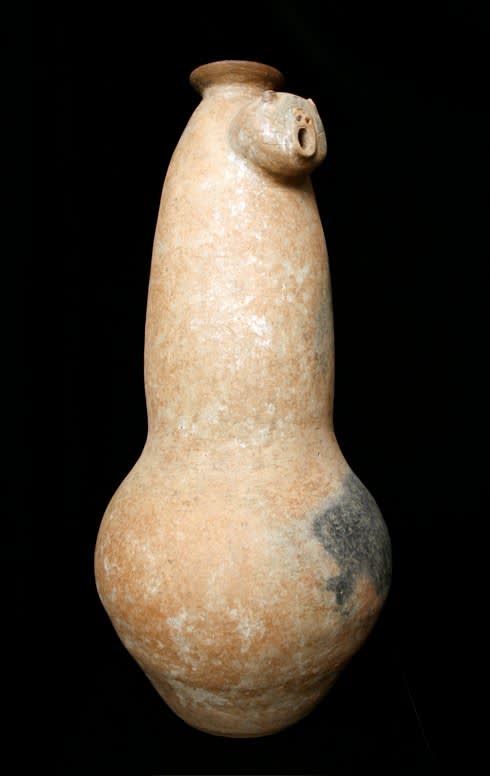Large Terracotta Vessel with a Pig-Shaped Spout, 19th Century CE - 20th Century CE
Terra Cotta
32
DE.008 (LSO)
Further images
This whimsical ceramic vessel with a pig-face-shaped spout exemplifies the effervescent tradition of adorning utilitarian and secular objects for no better reason than amusement and appreciation of the decorative. The...
This whimsical ceramic vessel with a pig-face-shaped spout exemplifies the effervescent tradition of adorning utilitarian and secular objects for no better reason than amusement and appreciation of the decorative. The vessel itself is formed in the likeness of a gourd, with a large, rounded base and a tall body that narrows to a rimmed pouring spout. The ground is pale, hard ceramic, with dark, irregular patches. The pig’s face projects from the body about 1/3 of the way down, and is formed from a circle for the head and a vertical oval for the snout. A mouth has been pierced through both elements so that water or maize beer can be poured from it. It also has incised nostrils and applied ears, as well as facial incisions that are presumably meant to highlight the fact that it appears to be squealing.
This vessel constitutes something of a challenge, as it is outside the usual remit of known tribal art traditions. Logically, one might assume that it cannot be from any area that is predominantly Islamic, as both figurative arts and pigs are frowned upon by Quranic law, but this is hardly restrictive in terms of possible candidates. It does however seem to suggest West rather than East Africa. The main possibility is the Dogon, who are invariably enthusiastic in their decoration of everyday items, and who have successfully managed to avoid Islamic influence despite the extreme proximity of Muslim communities. It is also possibly from the Chokwe, the Bambara (Bamana) or maybe the Nupe, although their pots tend to be more abstract with animals being incised rather than modelled in relief.
Whatever its origin, however, this is a charming and amusing piece of African art, and a credit to any collection or sophisticated domestic setting.
This vessel constitutes something of a challenge, as it is outside the usual remit of known tribal art traditions. Logically, one might assume that it cannot be from any area that is predominantly Islamic, as both figurative arts and pigs are frowned upon by Quranic law, but this is hardly restrictive in terms of possible candidates. It does however seem to suggest West rather than East Africa. The main possibility is the Dogon, who are invariably enthusiastic in their decoration of everyday items, and who have successfully managed to avoid Islamic influence despite the extreme proximity of Muslim communities. It is also possibly from the Chokwe, the Bambara (Bamana) or maybe the Nupe, although their pots tend to be more abstract with animals being incised rather than modelled in relief.
Whatever its origin, however, this is a charming and amusing piece of African art, and a credit to any collection or sophisticated domestic setting.











